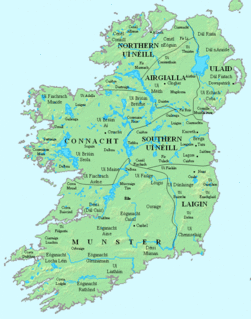Brión, son of Eochaid Mugmedón, was a legendary and possibly historical Irish king, fl. 4th/5th century.
Eógan Bél mac Cellaig was a king of Connacht from the Uí Fiachrach branch of the Connachta. He was the grandson of the high king Ailill Molt. His reign began sometime after 500.
Ailill Inbanda mac Eógain was a king of Connacht from the Ui Fiachrach branch of the Connachta. He was the son and successor of Eógan Bél, who was slain by the northern Ui Neill in 542. His nickname Inbanda means "womanish" or effeminate or it could mean "the vigorous" which is more likely.
Rogallach mac Uatach was a king of Connacht from the Uí Briúin branch of the Connachta. He was the son of Uatu mac Áedo, a previous king. He acquired the throne of Connacht after defeating the previous king Colmán mac Cobthaig of the Ui Fiachrach Aidhne, who was slain at the Battle of Cennbag in 622. Professor Francis Byrne believes he is the first reasonable representative of this branch to be said to have held the throne of Connacht
Colmán mac Cobthaig was a king of Connacht from the Ui Fiachrach branch of the Connachta. He was the first king of Connacht from the Ui Fiachrach Aidhne branch. This branch was descended from Eochu, the brother of Ailill Molt. According to the Book of Ballymote he was the grandson of Goibnenn mac Conaill (flor.537), the first Aidne king mentioned in the annals, but Rawlinson Genealogies name his grandfather as Gabrán.
Echu Tirmcharna mac Fergusso was a king of Connacht from the Uí Briúin branch of the Connachta. Genealogically he is mentioned as the great-great grandson of Dauí Tenga Uma a previous king. Prof. Byrne believes that the early Uí Briúin genealogies are fabricated however. His place in the king lists falls between the reign of Ailill Inbanda and of his son Áed mac Echach Tirmcharna. The Annals of Tigernach simply mention him as king in 556 and his son's accession to the throne in 557.
Feradech mac Ross was a King of Connacht from the Ui Fiachrach branch of the Connachta. He was of the Fir Chera sept of this branch descended from Macc Ercae, a son of Fiachra, the ancestor of the Ui Fiachrach. Feradech was the great-grandson of this Macc Ercae.
Áed mac Echach Tirmcharna was a King of Connacht from the Uí Briúin branch of the Connachta. He was the son of Echu Tirmcharna mac Fergusso. He came to the throne in the year 557 and ruled until 575.
Uatu mac Áedo was a King of Connacht from the Uí Briúin branch of the Connachta. He was the son of Áed mac Echach Tirmcharna. The kinglists place his reign after his father which would put his succession in the year in 575. Prof. Byrne preserves this arrangement but points out that the Annals of Ulster do not name him as king at his death obit and he does not agree that the early Uí Briúin kings held the overlordship in Connacht.
Loingsech mac Colmáin was a king of Connacht from the Ui Fiachrach branch of the Connachta. He was of the Ui Fiachrach Aidhne sept this branch and was the son of Colmán mac Cobthaig.
Muirchertach Nár mac Guairi was a possible King of Connacht from the Ui Fiachrach Aidhne branch of the Connachta. He was the son of Guaire Aidne mac Colmáin, famous in Irish sagas.
Cenn Fáelad mac Colgan was a King of Connacht from the Uí Briúin branch of the Connachta. He was of the branch which developed into the Uí Briúin Seóla, who were centred on Tuam in modern County Galway. He is the first member of this branch mentioned in the annals.
Indrechtach mac Muiredaig Muillethan was a King of Connacht from the Uí Briúin branch of the Connachta. He was the son of Muiredach Muillethan mac Fergusso, a previous king. He was of the Síl Muiredaig sept of the Uí Briúin.
Domnall mac Cellaig was a King of Connacht from the Uí Briúin branch of the Connachta. He was the son of Cellach mac Rogallaig, a previous king. The sept of Ui Briun he belonged to was the Síl Cellaig of Loch Cime.
Cathal mac Muiredaig Muillethan was a King of Connacht from the Uí Briúin branch of the Connachta. He was the son of Muiredach Muillethan mac Fergusso, a previous king and brother of Indrechtach mac Muiredaig Muillethan. He was of the Síl Muiredaig sept of the Uí Briúin. He ruled from 728 to 735.
Áed Balb mac Indrechtaig was a King of Connacht from the Uí Briúin branch of the Connachta. He was the son of Indrechtach mac Muiredaig Muillethan, a previous king. He was of the Síl Muiredaig sept of the Uí Briúin. His sobriquet Balb means "Stammerer".
Ailill Medraige mac Indrechtaig was a King of Connacht from the Uí Fiachrach Muaidhe branch of the Connachta. He was the son of Indrechtach mac Dúnchado Muirisci, a previous king and grandson of Dúnchad Muirisci mac Tipraite. He was the first member of this branch since 707 to hold the Connacht throne which had been dominated by the Uí Briúin since that time. He reigned from 756 to 764.
Flaithrí mac Domnaill was a King of Connacht from the Uí Briúin branch of the Connachta. He was the son of Domnall mac Cellaig (d.728), a previous king. The sept of Uí Briun he belonged to was the Síl Cellaig of Loch Cime. He reigned from 773-777.



